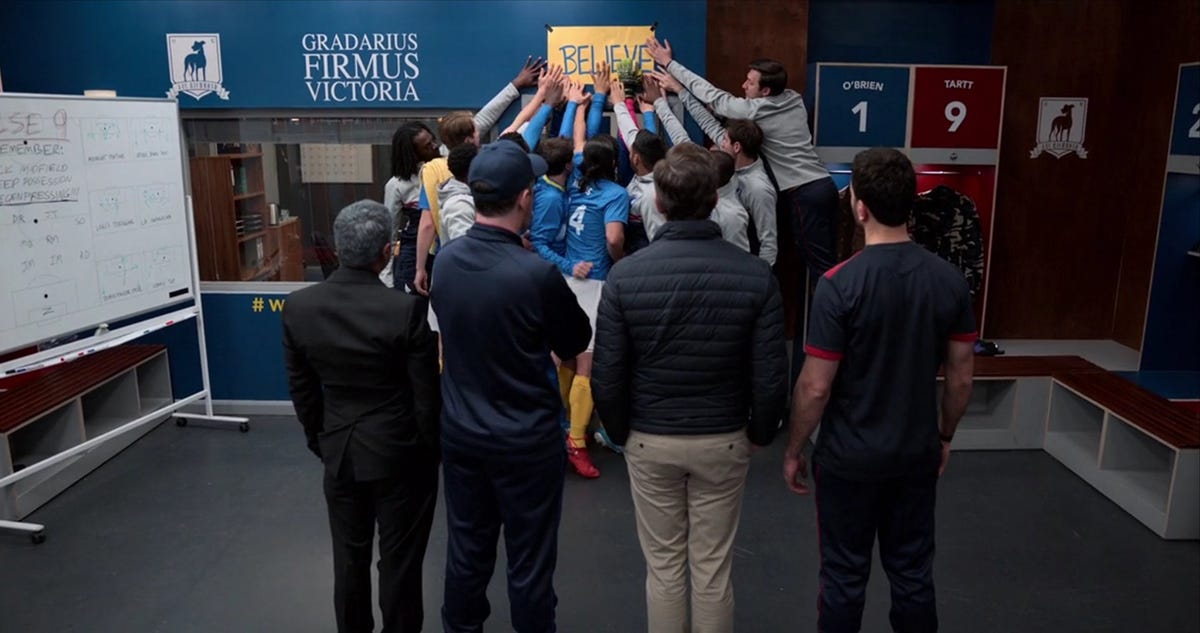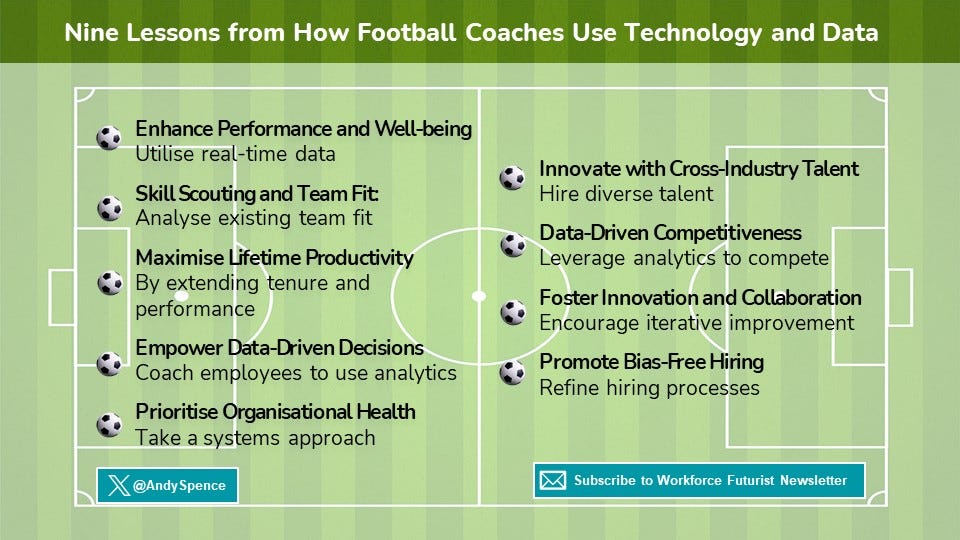Defying the Odds With Unconventional Strategies and Smarter Talent Scouting
#WF49 - Nine Lessons from How Football ⚽ Coaches Use Technology and Data (2nd Half Report)
The Women’s World Cup Final 🏆 ushered in a new era of heroes, villains, and inspiring stories. Among the captivating displays on the pitch, countless equally remarkable performances unfolded behind the scenes, forever hidden from our view.
Today, I delve further into football coaching and its valuable lessons. This marks the concluding part of a two-part article; if you haven't already, consider reading the first half here ->
From Lionesses to Flying Wingers: Revealing the New Heroes of The Beautiful Game
“Playing football is very simple, but playing simple football is the hardest thing there is.” Johan Cruyff As the Women’s World Cup Final takes centre stage in Sydney and the Premier League ignites passion, the beautiful game will yet again generate stories of heroes.
Here are four more lessons we can learn from football:
6. The New Heroes of Football – Talent Spotters’ Algorithms
7. David Vs Goliath – How to Beat the Odds In Your Industry
8. Total Football - Changing the Rules of the Game
9. ‘Need Not Apply’ – Removing Bias to Maximise Returns on Investment
I hope some of these shots hit their intended target…
You are reading Workforce Futurist Newsletter, if you haven’t done so already please subscribe to get insights on the Future of Work direct to your inbox.
6 - The New Heroes of Football – Talent Spotters’ Algorithms

The ‘Moneyball’ approach, popularised by Michael Lewis' book and the subsequent film, has had success in football. The approach involves using data and analytics to identify undervalued players possessing specific skills or attributes that contribute to team success, often at a lower cost compared to more well-known players.
Michael Edwards went to Liverpool FC in 2011, and built a data department that included an astrophysicist, a chess champion, and a former researcher on the Higgs boson at CERN. The story goes that their analysis identified Mohamed Salah; however their manager, Jurgen Klopp, was not convinced at the time. The rest is history, with Salah winning Golden Boots and multiple Trophies.
The approach of Edwards was a shift-change from previous generations of football scouts. The results are loved by fans and club owners alike, and this type of analysis is also well-received by some players too.
“The 40 to 50 page scouting report on me was really impressive. It contained everything about my private life, and every game, strengths, and weaknesses”
Pascal Groß outlines why he joined Brighton and Hove Albion Football Club in 2017.
Scouting Tips for Employers
A glance at HR team sheets reveals that numerous top-tier organisations have embraced People Analytics functions. Throughout time, the most adaptable organisations in the face of external shifts have demonstrated the ability to realign their workforce effectively. The essence of Moneyball tactics in sports transcends data, technology, or algorithms; it pivots on human ingenuity and the courageous pursuit of unconventional strategies. Illustrated by the acquisition of Liverpool FC by new American owners, their audacity to think beyond the norm is exemplified in their recruitment of talent from diverse fields. Despite initial skepticism, their bold sporting gamble ultimately yielded success.
7 - David Vs Goliath – How to Beat the Odds In Your Industry
Can AFC Richmond win the Premier League? Ted Lasso believes they can.
No TV spoilers here, but does this happen in real life?
⚽ Greece’s football side were 150 to 1 to win the 2004 European Championship
⚾ Minnesota Twins were 500 to 1 to win Baseball’s 1987 World Series
⚽ Leicester City were 5,000 to 1 to win 2015-16 English Premier League
The players of 22/23 Premier League winners Manchester City are estimated to be worth €1.25 Billion (Source - Transfermarkt).
Luton Town were promoted to the same league for the first time since 1980, the value of their squad is estimated at €72m.
How can Luton Town possibly compete in the same league with Manchester City, whose talent pool is worth 17 times more?
Leicester City won the Premier League by recruiting players based on data-driven analysis of performance metrics, allowing them to assemble a competitive squad without the financial resources of larger clubs. Their ruthless counter-attacking tactics were innovative and hard to defend, and they had some luck without major injuries.
There are many examples of football teams punching above their weight using data analysis that include:- Brentford, Benfica (their academy is the most profitable in the world, generating 379m euros (£336m) since 2015), Brighton and Hove FC, Danish FC Midtjylland, and, RB Leipzig in Germany.
As you might expect the methods of these businesses are guarded with more secrecy than Saturday’s team selection, and there have also been examples of hacking by competitors.
Beating the Odds in Your Industry
Most industries have companies that dominate their market, we know all about the myths of the business school case-studies, for example,
Netflix Vs Blockbuster, Dollar Shave Club Vs Gillette, Apple Vs Nokia
All have fairly unique situations and context, which are not easily replicable.
If only business was as easy ‘cut and pasting’ examples from other industry, hacking into a rival’s database⚠️, or paying for ‘best-practice tips’.
In football, Leicester City, demonstrated how to beat the big boys.
There is no easy answer. Being at the right place at the right time, the smart use of analytics, and innovative decision-making, with a dose of luck.
8 - Total Football - Changing the Rules of the Game

We can play by the rules, competing pretty much the same way as the others, make some innovations, and win our fair share of games.
Then a new approach arises, and slow, slow, quick - people jump ship.
Sometimes fresh innovation emerges and makes you fall off your chair.
In the 1974 World Cup, the Netherlands replaced Brazil as the crowd pleasers, and made it to the final of the World Cup. Playing expressive, fluid football - it was an unconventional strategy that effectively did away with positions — players were interchangeable on the field at all times.
Total Football (or Totaalvoetbal for my Dutch friends) was a style of play in which success thrives on a collective understanding of space and movement among all 11 players. Associated with Cruyff, Rinus Michels, Ajax, and the Netherlands national football team.
Total Football wasn't solely a gameplay style; it embodied a mentality that challenged the confines of convention and urged players to transcend their predefined roles.
As with most innovations, it didn't spring forth in isolation; rather, it was an adaptation of strategies employed by exceptional teams of the past.
So, what insights can we glean from the philosophy of Total Football?
Parallels Between Total Football and Agile Methods
It might be argued that at a certain level, there are parallels between Total Football and Agile Methodology – an approach used in software development. Agile is an iterative approach that focuses on collaboration, customer feedback, and adaptability. It is hard to accurately evaluate the impact of Agile. For example in this McKinsey report, it is impossible to isolate cause and effect drivers from Agile Vs other activities also found in other transformation methods.
There are some interesting similarities between Agile and Total Football:
Encouraging experimentation and risk-taking - Total Football was known for its innovative and experimental approach to the game, with players encouraged to take risks and try new tactics. In 2016-2019 the Dutch bank ABN AMRO implemented a large-scale Agile Operating Model involving more than 6000 employees - you can read the academic case study here. No glib one-sentence summaries here I’m afraid, but an interesting comment from researchers, “The role of the individual, with their skills, mindset and behaviour are imperative in in the journey towards a nimbler and more innovative financial service provider.”
Collective Responsibility and Collaboration - Total Football emphasises the collective responsibility of all players to defend and attack. Similarly, Agile teams share the responsibility for delivering project outcomes
Continuous Improvement and Iterative Approach - Like Total Football's fluid movement, Agile adopts an iterative approach. Agile projects are divided into smaller iterations or sprints, allowing teams to continually assess progress, receive feedback, and make adjustments.
Fluid Roles and Adaptability - Total Football requires players to work closely together (but not too closely together with reference to the ‘The Strings That Bind Us’ Episode on Ted Lasso) and be comfortable in multiple roles.
The Cruyff Turn
Total Football is much more than the ‘Cruyff Turn’, but this makes me smile every time…
A Deeper Dive Into Football Network Analysis
The diagram at the top of this section is a schematic illustration of a football passing network. In the plot, players are represented by circular nodes, whose size is proportional to their importance in the network. The position of each player is given by the average of the positions of all passes made by the player during the match. The width of the links is proportional to their weights, which account for the number of passes between players. The example is a match between Barcelona and Real Madrid, played during the season 2009/2010. Those who are particularly interested can read the paper in Nature - Defining a historic football team: Using Network Science to analyse Guardiola’s F.C. Barcelona.
And here you can read more about how Organisational Network Analysis is used in work.
If you are reading this article from an email, you can read on a browser here if you prefer.
9 - ‘Need Not Apply’ – Removing Bias to Maximise Returns on Investment
In their book, “Soccernomics”, Simon Kuper and Stefan Szymanski, asked the question “Does English Soccer Discriminate Against Black People?”
They analysed the accounts of forty clubs from 1978 to 1997 and found that wage spending accounted for 92% of the variation in league positions.
So far, so predictable.
You would expect the market in players’ pay to be highly efficient in football, the better a player, the more he earned. In theory, this is because market conditions are good, with lots of buyers and sellers, and good information. If there is discrimination, they would expect to find black players earning less than equally talented white players.
They deployed the economist’s favourite tool, regression analysis, to isolate the distinct effects of wages and the share of black players on each club’s league performance. The data showed that teams with more black players indeed had better league records than those with fewer black players, even when considering wage spending. If two teams had identical annual wage budgets, the team with more black players would finish higher in the league. The test implied that black players provided better value for money compared to white players.
They ran the regression analysis to the end of the 1990s. For these six additional years, there was no evidence that the share of black players in a team had any effect on team performance, after allowing for the team’s wage bill. In other words, by that time, black players were being paid what they were worth to a team, indicating market adjustments.
Question for Employers
Does your hiring have discrimination or bias that weakens your capability against your competition, and how do you know?
Employer Tip - Reducing Bias In Job Descriptions
One way that employers can reduce bias in hiring is to improve the ubiquitous Job Description. For example, Textio, has a tool that has been used to statistically analyse response patterns to different words, including in the job description. When considering gender-specific responses, certain phrases like "Work hard, play hard" or "Coding Ninja" tend to resonate more with male audiences in advertisements. Conversely, terms such as "adaptable and creative" tend to draw increased attention from women.
Coaching Notes Summary
Post-Match Analysis
So playing football is very simple, but playing simple football is hard.
There is nothing simple about the ‘Cruyff Turn’ - try it next time you are kicking the ball about in the park - but please be careful.
It’s similar with our work in other industries. The winners make it look easy.
Cruyff also had a warning about relying TOO much on analytics,
"I find it terrible when talents are rejected based on computer stats. Based on the criteria at Ajax now I would have been rejected. When I was 15, I couldn’t kick a ball 15 metres with my left and maybe 20 with my right. My qualities technique and vision, are not detectable by a computer."
As the final whistle blows, football's blend of skill and chance mirrors our lives and workplaces.
Through this article of two-halves, I have attempted a few hopeful passes into the Executive box. Just like on the pitch, some of these efforts will gracefully find the back of the net, while others might veer off course.
Yet, here we stand, with the ball now resting at your feet…
This is the 2nd half of a 2-part article - read the 1st-half report here.
Thanks to Ewan 🙏🏽
If you enjoyed this article then please share it with your network with future articles on the future of the firm, web3 and AI, demographics and building a better world without jobs.








